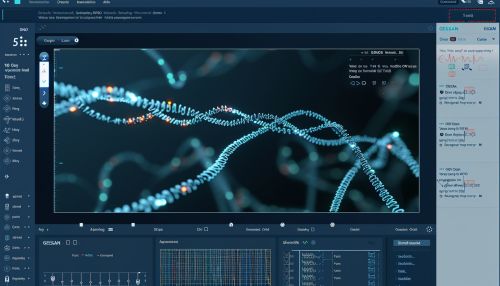GENSCAN
Overview
GENSCAN is a bioinformatics software tool used to predict gene structures in genomic DNA sequences. It was developed by Chris Burge and Samuel Karlin at Stanford in the mid-1990s. GENSCAN is widely recognized for its ability to accurately predict the locations of genes and their component parts, such as exons and introns, in a given DNA sequence.


Methodology
GENSCAN uses a combination of intrinsic signals and content sensors to predict gene structures. The intrinsic signals include promoters, splice sites, start codons, stop codons, and polyadenylation signals. The content sensors, on the other hand, are used to detect coding regions based on their statistical properties, such as codon usage and base composition.
The software employs a probabilistic model known as a hidden Markov model (HMM) to integrate these signals and sensors. The HMM allows GENSCAN to predict not only the presence of genes but also their exact boundaries and internal structures.
Accuracy
The accuracy of GENSCAN's predictions is measured in terms of sensitivity and specificity. Sensitivity refers to the proportion of actual genes that are correctly predicted by the software, while specificity refers to the proportion of predicted genes that are actually present in the DNA sequence.
In benchmark tests, GENSCAN has been found to have a high level of accuracy. For example, in a test using a set of human DNA sequences, the software correctly predicted 85% of the exons and 65% of the genes. However, like all gene prediction tools, GENSCAN is not perfect and can sometimes produce false positives or negatives.
Applications
GENSCAN is widely used in bioinformatics research and has been instrumental in the analysis of many genome sequencing projects. It has been used to predict genes in a variety of organisms, from bacteria to humans.
In addition to its use in gene prediction, GENSCAN can also be used to identify potential regulatory sequences and other functional elements in a DNA sequence. This makes it a valuable tool for researchers studying gene regulation and function.
Limitations
While GENSCAN is a powerful tool for gene prediction, it does have some limitations. One of the main limitations is that it assumes that genes are independent of each other, which is not always the case in complex genomes.
Another limitation is that GENSCAN does not take into account the biological context of a gene, such as its expression level or its role in a particular biological process. This means that the software may not be able to accurately predict genes that are only expressed under certain conditions or in certain tissues.
Future Directions
Despite these limitations, GENSCAN continues to be a valuable tool in bioinformatics research. Future developments in the field may lead to improvements in the software's accuracy and functionality. For example, advances in machine learning and artificial intelligence could potentially be used to enhance GENSCAN's gene prediction capabilities.
